Neil Gaiman is widely-known for his fantasy-style work and his a unique repertoire of novels, short stories, and comics. As someone who had fallen in love with The Graveyard Book, I was thrilled to see what he would share about coming up with ideas and building a story.
But if you’re here, you might be wondering if Neil Gaiman’s MasterClass is worth it and whether it has something to offer you? So this balanced Neil Gaiman MasterClass review is here to help you decide.
If you just want the headlines or are pushed for time, this summary is for you:
.
Quick summary
You will learn to:
- Use storytelling to create compelling writing
- Play with language and build a strong narrative world
- Use form to enhance plot
- Edit your work and get it published
Pros
- Learn from a world-renowned author and experienced teacher
- Good balance of theory & practice
- Detailed class with high production values
- Subscription gives access to 20+ other world class writers
Cons
- Targeted towards young writers
- Advice can be abstract
Course length: 19 videos 4 hours and 51minutes.
Best for: Anyone starting their writing journey, especially younger writers, and those more experienced who are seeking motivation and inspiration.
Overall: Neil’s course was a joy to listen to and struck more of an emotional chord than other writing courses I have taken. Neil makes the viewer feel like they can do anything they set their mind to, and I was glad he’d let me into his world.
Now we’ll move on in more detail to the many strengths and virtues of the course as well as a few ways that it falls a little short.
I’ll be covering the following:
- A brief overview of Neil Gaiman and MasterClass
- An overview of Neil Gaiman’s MasterClass
- What I liked and disliked
- Who this course is for
- Alternatives
- What others have said
- Whether the course is unique and worthwhile.
So, let’s get started.
About Neil Gaiman
Neil Gaiman is arguably the most renowned fantasy writer of our times. His most famous works include Coraline and American Gods.
His young adult fantasy novel, The Graveyard Book, topped the New York Times Bestseller list for 61 weeks.
He won the Book of the Year award for his 2013 novel, The Ocean at the End of the Lane.
As one of my favourite young adult authors, I was eager to see what Neil Gaiman had to say about the art of storytelling.
If you haven't seen the trailer for Neil's MasterClass I highly recommend you check it out:
About MasterClass
“Our instructors are the best in the world.”
MasterClass is an online learning platform founded in 2015. It offers over 150 courses from experts in various fields.
The course instructors are all well-known personalities, such as Hans Zimmer, Gordon Ramsay, Chris Voss, Judy Blume, Dan Brown and Margaret Atwood. So you know you’ll be hearing from the best.
Famed for its outstanding production values, MasterClass is also rigorous when it comes to quality of content and learning materials. This combination provides a unique and compelling learning experience.
Having taken more than twenty MasterClasses myself, I can report that many are fantastic and insightful. However, some are definitely better than others. And it’s important to do your research first to make sure the course you’re thinking about is the right one for you.
If you want more details on MasterClass and some of its most popular classes, check out our Masterclass review and best MasterClass article.
Inside Neil Gaiman’s MasterClass
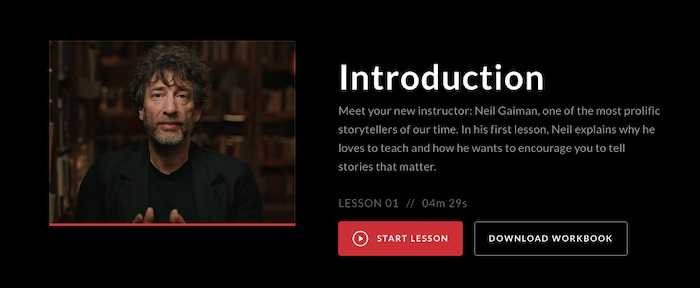
Neil Gaiman’s MasterClass has 19 videos between 10 and 25 minutes long. This totals a generous 4 hours and 50 minutes.
As well as video content, there is also a PDF Workbook you can follow alongside each lesson. The Workbook contains exercises to help you put Neil’s advice into practice. It has a recommended reading list for those wanting to go beyond the course.
After this short introduction, the course continues as follows.
Lesson 2: Truth in Fiction
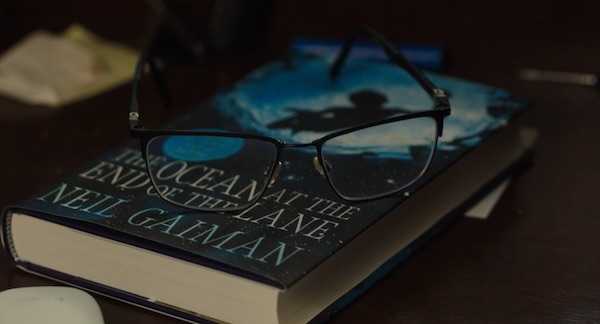
In this section, Neil introduces us to the subject of storytelling and truth-telling in fiction. This was a great way to frame the course and helps us gain insight into Neil’s mindset. As he puts it, Neil wants this lesson (and the rest of the course) to give us a push forward that “we might not otherwise get.”
For Neil, stories are “the most interesting phenomena that human beings have.” He uses this as a starting point, and tells us how stories can give us a handle on the rest of the book.
According to Neil, stories are a way to give readers information that they will remember, and we can achieve this by toggling between truth and lies.
As I expected, his advice was quite whimsical. Anyone familiar with the author will know he likes to talk in metaphors and has a philosophical style of delivery.
As a former professor, Neil uses storytelling as a way to teach. This gave the lesson an interesting “meta” quality and teaches by example (i.e. telling a story in itself).
Lesson 3: Sources of Inspiration
Here, Neil shares with us his metaphor of the “compost heap.” This refers to the process of collecting ideas for your story, and is a good way to consider inspiration as building a literary armory.
What I found particularly useful was Neil sharing his sources of inspiration. He teaches us to go beyond other writers and even tells us some of his favourite influences growing up.
He covers some important and sometimes overlooked topics in this lesson:
- How to bounce ideas off one another
- Different ways of telling stories
- How to make stories your own
- The art of observing in everyday life
Compared to the previous lesson, Neil’s advice here is a lot more concrete and he gives us some sound tips on how to find and develop a good idea. In particular, his use of case studies from his works are invaluable for learners like myself, who need to have tactile examples of how to put theory into practice.
Lesson 4: Finding Your Voice
Neil continues by teaching us how to find our voice through reading, experimenting, and trial and error. He sees this as a crucial part of bringing our stories to life and finding the right footing for our writing.
He also discusses the usefulness of mistakes and helps us to see it as a process rather than a failure. I felt this was a great way to get the reader out of a writing rut, overcome self-doubt, and gain the skills they need to get going.
The Workbook is a useful resource here as it is filled with question prompts to get you thinking about tone of voice, point of view, and how to write convincingly.
Lesson 5-10: Developing the Story
Personally, I found these lessons to be the crux of the course. Neil starts out by posing the question: how do you build a story from an idea?
Neil focuses on the following:
- What you need to know before you write
- Mistakes young writers make
- What fantasy writing is all about
- How to create and develop your plot
Throughout these lessons, Neil interweaves short case studies to illustrate his advice. For example, he dedicates a video lesson to analysing The Graveyard Book, and pieces apart his opening scene to showcase what makes it so effective.
MasterClass intersperses Neil’s course with useful visuals. These include highlighted quotes (and even illustrations), which are great for holding our attention.
In terms of structure, these are amongst the best lessons I’ve come across. Neil reads excerpts from his books and helps us to see them in light of what we have learnt. These examples are a good way to reinforce lessons and to illustrate his techniques.
As a bonus, his reading voice is very relaxing. I actually wouldn’t be surprised if people took the course for this alone.
Lesson 11-13: Worldbuilding

Beyond the process of telling a story, Neil prompts us to consider our fictional world. He sees worldbuilding as a formula that can create credibility, and advises us on how to do the following:
- Use the world around you to inform the world of your story
- Determine the rules of your world
- Research for inspiration
- Approach books with “fresh eyes.”
It was in this section that I saw a lot of Neil’s humanity as an author. In fact, there was a lot that was relatable for any aspiring writer. He tells us how he put off writing The Graveyard Book for nearly 20 years and even shows us one of the notebooks he carries around with him.
This exclusive insight into the writer’s mind made writing a book seem a lot more possible. Writing was suddenly not out of reach, but available to anyone if they worked hard enough.
Lesson 14-16: Genre

In this section, we learn how to use literary “rules” to our advantage. Neil covers the following:
- Assessing and playing with reader’s expectations.
- Understanding genre and using it as a framework.
- Using genre as a springboard for your writing.
His key lesson is on the unexpected relationship between plot and genre. He makes us consider genre in a new light and to see it as a tool by which to advance a story.
Lesson 17-19: Overcoming Writer’s Block and Editing
Neil rounds off his course by sharing ways you can avoid giving into the despair generated by a blank page, and how to get a grip onthe editing process (which he described as two-fold).
He teaches us to use method acting when editing, and, in the style of an encouraging teacher, prompts us with questions to get us thinking about our drafts.
In fact, Neil’s approach to determining what stays in and out of the final draft really changed my outlook. He gave us what felt like a pep talk, parting with words of encouragement and the reminder that “perfect does not happen in this universe.”
What I Liked About Neil Gaiman’s MasterClass
As a course nearly 5 hours long, it’s difficult to do justice to its quantity. Neil almost spoils us with his videos on case studies, short stories, and even comics.
There is a lot I enjoyed about Neil’s course, which I will highlight below. However, I don’t believe this course is without its flaws, and I will also tell you where I think it could be improved.
Learn to Write Professionally
There is no doubt that Neil Gaiman is a hugely successful writer, and this course gives us some great advice on how to follow in his footsteps. He teaches us to consider writing not only as a hobby but as a viable career, and even tells us how to get published.
He gets to the nitty-gritty of what writers actually do and this is helpful for anyone looking to break into writing professionally. Neil’s teaching style is conversational and engaging. He makes us believe the old adage that everyone has a novel in them.
I liked that he gave an honest view of the realities of writing (through the good days and the bad) and advised on navigating the turmoils that come with such a job.
Towards the end of the course, he tells us what steps to take to get an agent. This includes writing a query letter and a synopsis. I appreciated that Neil went beyond the abstract and helped us to see writing as a plausible career.
Connect with Your Reader Emotionally
One thing I found really heartfelt about Neil’s lessons was the attention he gave to his audience. He suggests that writers are indebted to their readers and, like other writers I had heard from, he emphasised the emotional contract between writer and reader.
While Neil doesn’t profess to know any ultimate truths about writing, he does give us some eye-opening tips on how to connect with our readers through storytelling. In particular, he tells us how to establish a moral crux that the reader can take with them.
Hearing about Neil’s success in affecting his readers emotionally, I was impressed by how intimate the act of writing and sharing stories could be. Neil gives great advice on how to add emotional depth to stories.
How to Use Short Stories as a “Magic Trick”
One lesson I really enjoyed was on short stories. In this topic, Neil teaches us how to use word choice and plot to create what he calls a “magic trick” by the end of the tale.
Drawing on popular fairy tales, he teaches us how short stories differ from novels, and tells us how to use language and form to reel in our readers.
Informative Workbook
Of all the Workbooks I’ve seen on MasterClass, this is one of the most helpful when it comes to structure. It contains lots of practical information that is well-laid out and clearly headed. It highlights key points and enlarges its subheadings, making it easy to scan.
I liked that this Workbook included a good balance of theory and practice. It was especially helpful in its section on “Genre Charts,” in which common fictional genres were laid out with relevant examples.
The Workbook also includes excerpts from Neil’s short stories (including a full copy of his October Tale). While he reads many aloud, it can be helpful to follow along and make notes.
In fact, the Workbook is versatile enough to be used either separately or alongside the videos, depending on your preference. Either way, I think it’s a great resource to return to after the class, as it expands on a lot of the terms Neil mentions.
What I liked most was that it was a standalone resource. While it lists some secondary reading, you need no extra tools to use it. This makes it accessible to all and is a great way of getting you involved in the exercises.
Become Motivated to Finish
“The hardest part as a young writer is finishing.”
It might be the former teacher in him, but Neil is great at motivating his students to not only start writing, but to follow through with it each day. He asks motivating questions that can “open the door to what you do next.”
As you’d expect from the fantasy writer, a lot of his wording is fanciful and exciting. He refers to stories as magic and makes us want to create our own.
While some of his language can seem over-the-top, he balances it with a lot of sound advice about finding inspiration and practicing your craft. He even dedicates lessons to writing beginning and endings. Neil’s teaching definitely had a charm that made me want to get involved.
New Ways of Looking at Writing
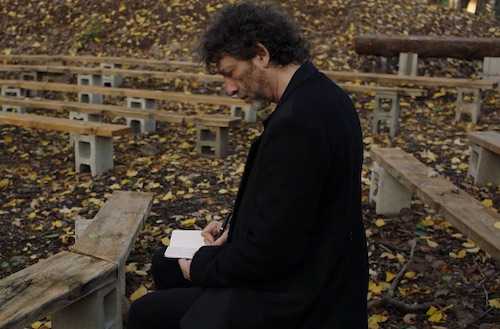
Like many other writers, Neil shares (and even coins) some terms to illustrate his writing techniques. He teaches us the “crucible effect” and the “American transparent,” both of which help us to look at writing from a new point of view. This helps us to consider the scope of storytelling, and how to use these techniques to add flair to our writing.
In fact, some of my favourite takeaway points came from Neil’s discussion of the late Terry Pratchett. As his fellow collaborator on Good Omens, Terry coined his own terms when writing as a fun way to describe his style.
Neil tells us how to create humour using Terry’s “Figgins” and “sherbet lemons.” I found these strange terms both comical and useful. They gave a name to storytelling elements I had seen in practice, and equipped me with some new tricks to use in my writing to make it more compelling.
Balance of Theory and Practice
Although many of us know and love Neil’s unique writing style, I don’t think this course would’ve worked as well if it wasn’t balanced by a practical side.
While he takes the time to share his stories and encourage us to experiment, he concedes that there are practicalities you must follow in order for your writing to “work.”
He distills literary terminology for us, breaking down some theory and teaching us how to use it. Alongside this, the Workbook gives us some helpful advice, including how to use the Pomodoro technique to write in short bursts.
Neil also took the time to show us the physical process of creating Sandman #19. He let us peek at his doodles and taught us how to use page turns for emotional impact. This went beyond the whimsical advice to show rather than tell, and cement a lot of abstract theory.
How to Use Dialogue to Create Character
Neil helpfully spends time considering the error some writers make of not diversifying their characters.
He is critical of writers who confuse their reader with too many people, and tells us how to focus on making characters distinctive through voice so the reader is in no doubt about who is speaking..
Most of us have experienced the trouble of flicking back through pages, trying to figure out who is speaking. I liked that Neil addressed this, and he taught us some good ways to define characters.
What Could Be Improved
While Neil’s course was insightful and personable, I did think there was room for improvement. Here are some points you might want to consider before committing to the course.
Spoilers
By using many of his own works as case studies, it’s hard to avoid spoilers (though Neil does his best to keep these to a minimum). In the case of Coraline, it’s worth bearing in mind that Neil reveals some key plot lines. This might disappoint some learners!
While it’s good to have some knowledge of Neil’s books, the Workbook is quite useful in giving summaries to help you understand the given excerpts.
Abstract Advice
While Neil does go into the “nuts and bolts” of a good story, there’s only so much advice a writing course can give. Inevitably, this is the nature of such a course, which, unlike cooking or sewing, cannot be wholly objective.
I would say that Neil strikes a good balance between the abstract and the concrete, but some may find his style of delivery a bit too vague for their liking—especially in the early lessons.
Neil’s course could benefit from some on-screen bullets to summarise key points. Aside from the Workbook, we are often left to unpick Neil’s lessons ourselves, and his storytelling approach can sometimes be hard to follow.
Emphasis on Young Writers
Neil seems to target the “young writer.” While it’s a minor detail, it did crop up quite frequently and seemed to exclude those getting into writing at an older age (or, those that had written for years and still wanted help).
On the one hand, Neil has a largely young adult demographic, so it’s understandable that his advice is geared towards those in their late teens and early twenties.
However, I still think Neil could’ve considered a broader scope to help everyone feel included.
Lengthy Videos
This might not be a drawback for some, but it’s worth noting that some of Neil’s videos are nearing half an hour in length.
This can make it difficult to focus across several videos (especially alongside the Workbook). In fact, I found I needed to take frequent breaks to help the lessons sink in.
Who is this course for?
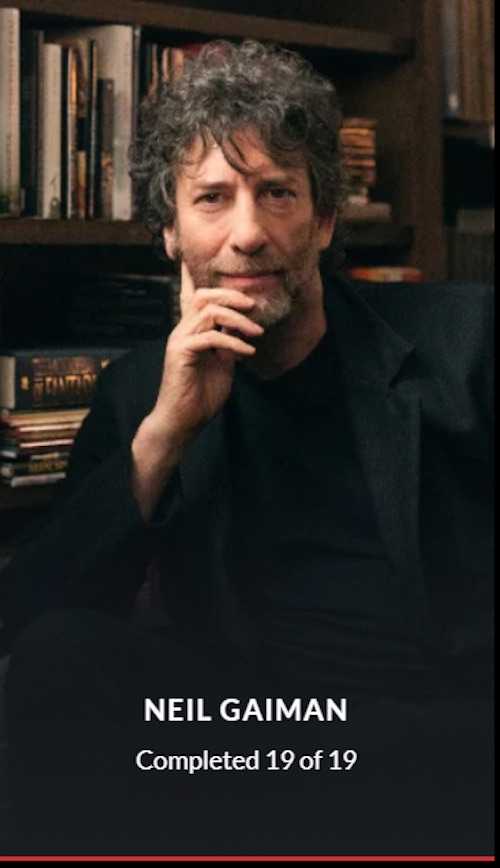
MasterClass is advertised as being for anyone and everyone, and Neil’s teaching style is both gripping and explanative.
However, this course seemed to be mostly suited for younger writers, with the assumption that we were all starting out and perhaps making the same mistakes.
For professional writers, I still think Neil’s lessons are motivating and helpful. If nothing else, they inspire a strong sense of ambition and a can-do attitude.
Neil genuinely made me want to write and to experiment with new techniques. I liked that he distilled many abstract terms like “genre” and “theme,” and how to ask a “dramatic question.”
In my opinion, anyone on this course can take away the following:
- Advice on how to manage the scope of your work
- Insight into life as a writer
- How to stay on track when facing obstacles
- How to imbue your work with values and moral messages
On a scale of 1-10 (1 being a novice and 10 being an expert), I would say this course appeals to those between 1-8.
How much does the course cost?
Currently, MasterClass has three subscription offers. The price for these (per month) are:
- Individual (1 user): $10
- Duo (2 users): $15
- Family (6 users): $20
All are billed annually, which may seem a little pricey at first glance.
That being said, the value for money comes from taking as many courses as possible.
With 200+ courses on MasterClass, you’re bound to find many that interest you. But, even if you find that only 10% of the courses interest you, this still works out at $6 per course.
And, if you join with friends or family, the cost for each course is drastically reduced. Check out our MasterClass review or MasterClass cost articles to see how.
Bearing in mind that these courses are taught by leading experts, the value for money is unbeatable. Elsewhere, you can pay over $100 for a course taught by someone you’ve never heard of, and it would nowhere near match the caliber of teaching on MasterClass.
Besides, MasterClass offers a 30-day refund policy if you’re not happy with your purchase.
You can also purchase MasterClass as a gift.
Alternatives to Neil Gaiman’s MasterClass
There are other writing courses available on MasterClass. They include (but are not limited) to:
- Dan Brown—Thriller Writing
- Margaret Atwood—Creative Writing
- David Sedaris—Storytelling and Humor
- Joyce Carol Oates—The Art of the Short Story
- Amanda Gorman — Poetry
- Billy Collins—Reading and Writing Poetry
- James Patterson—Writing
- Walter Mosley – Fiction and Storytelling
- Salman Rushdie – Storytelling and Writing
Each MasterClass includes a short trailer to help you decide whether the course is for you. For example, if you prefer a more practical style, Dan Brown’s course is a good alternative to Neil’s.
Outside of MasterClass there are a range of online writing classes.
Notable among these are Udemy's Creative Writing Masterclass and Skillshare's Storytelling 101. Udemy courses can be purchased individually for an average of $50, Skillshare is a subscription platform. You can find out more and read summaries of the best courses in our Udemy and Skillshare reviews.
If you are interested in a more academic approach with the chance of certification there are numerous writing courses from top universities on platforms such as Coursera or edX. The pricing structure for these is a little complex but generally, many courses can be taken for free but you have to pay for the certificate. Check out our Coursera and edX reviews for more information.
Neil Gaiman’s MasterClass: What Others Have Said
As one of the most popular writing courses on MasterClass, this course had a largely positive reception. Some users felt from the trailer that his advice seemed like a form of “life-coaching,” and were eager to learn more.
"This honestly sounds like a life coaching course more than a writing course and I am totally onboard with this." - Comment from YouTube
Most learners already seemed to be huge fans of Neil’s work, but there was a scattering of viewers who weren’t familiar with his books.
Aside from committed fans, there were clearly some who had come from adverts and were intrigued by MasterClass’s and/or Neil’s reputation.
I’m also glad that the “young writer” focus didn’t escape other learners. I often search Reddit to check others’ opinions before I commit to a course, and one user notes that Neil’s class leans more towards beginners. With that in mind, some advice is probably too obvious for more seasoned writers.
"I'm enjoying it - Gaiman is one of my favourite authors, and there are some excellent bits of advice in there - but it definitely trends downard when it comes to whether it's for beginngers VS advanced writers. It's all excellent advice, but I feel like I'm already following most of it. The valuable part of the class comes when he talks about his works in detail - what he wanted to convey, why he chose to do certain things, etc. If you're familiar with the books you can get a lot out of that." - Comment from the community
Perhaps due to Neil’s young readership, some questioned whether the cost would be worth it. For a single course, a few were unsure if the class was a viable option.
"So anyone tried this yet? Worth the money?" "Dude its Neil. Of course it's worth it." "This man can make fiction come to life. Of course it's worth it" - Comments from YouTube
One Reddit user also questioned how original the course would be, suggesting it was recycled information that was already readily available.
I think it’s hard to form a clear opinion if you haven’t taken the course. Neil’s MasterClass has a lot of good advice I’d never heard before. In fact, most users who had taken the course through to the end attested to its being worthwhile and would recommend it to others.
How long it took to complete the course
Neil Gaiman’s writing course consists of 19 lessons in total, and these add up to a viewing time just shy of 5 hours. Along with the Workbook exercises, this is a long course to get through, and I’d suggest giving yourself at least a week to get stuck in.
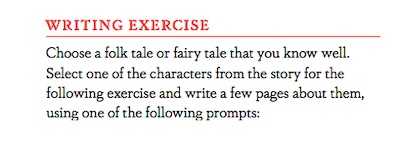
All in all, this course is full to the brim with good advice. From secondary sources, to comic-writing; humor-crafting and case studies, MasterClass ensures that users get what they paid for. There’s even some bonus content!
Is the content unique?
Neil Gaiman’s class is particularly characteristic of the author himself.
The collaborators clearly set their sights on recreating the “Neil Gaiman experience” and designed their videos with his fictional worlds in mind. Alongside the illustrated graphics and eccentric quotes, Neil gives advice which is unmistakably his own.
As some Reddit users pointed out, a lot of the information feels familiar.
"I think it's really cheeky of him. I don't even think he's a great writers - just a great ideas man - and putting himself on his own MasterClass on writing and charging poor indie folks loads to take it as though that'll make them successful like him, rather than just emptying their pockets..." - Comment from Reddit
However, while some information is available from other sources, MasterClass has condensed and distilled the key concepts into one course, which makes it easy for you to learn fast. The benefit of paying for MasterClass is the convenience of having valuable teaching in one spot.
What You Will Need
Aside from your attention, Neil’s class doesn’t require any tools. All you need is a word processing app or a pen and paper.
If possible, it’s good to familiarise yourself with Coraline, which is used as a case study quite early on.
Coraline is available on Amazon here.
Neil Gaiman MasterClass: is it worth it?
If you’re interested in writing fiction, this course is definitely worth it. It covered far more topics than I expected and gave me the confidence that I could write.
While the course is available to anyone, it’s mostly geared towards young writers that are just starting out.
In sum, Neil’s course was a joy to listen to and seemed to hit a bit more emotionally than other writing courses. Neil makes the viewer feel like they can do anything they set their mind to, and I was glad he’d let me into his world.
And don't forget, a MasterClass subscription gives you access to over 150 other classes, including 20 writing courses from the world's top authors, screenwriters and poets.
And with a 30 day money back guarantee you have nothing to lose by trying it out.
Frequently Asked Questions
An individual MasterClass all-access-pass costs $120 a year ($10 a month). This gives you access to Neil Gaiman, alongside 200+ other courses.
19 videos totalling just under 5 hours of viewing.
There is no way to access the course for free. The closest you can get to this is if someone buy you MasterClass as a gift. On the plus side, MasterClass offers a class sample as well as the online trailer, which is helpful for those that are still on the fence about the course.
Refunds are available up to 30 days from purchase if you obtained the class through MasterClass. If you purchased through another provider, their returns policy may apply.

Rebecca graduated from King's College university with a first class honours in English Language, followed by a Masters' Degree in Eighteenth Century Studies.



You have brought up a very fantastic details , thanks for the post.
Thank you! We’re glad you found the details helpful. We appreciate your support and look forward to sharing more valuable content with you!
Hello! Do you know if they make any plugins to assist with Search Engine Optimization? I’m trying to get my blog to rank for some targeted keywords but I’m not seeing very good gains. If you know of any please share. Thank you!
Hi! Yes, there are several great SEO plugins that can help improve your blog’s ranking. I’d recommend trying Yoast SEO or All in One SEO – both are userfriendly and effective for optimizing your content. Best of luck with your blog, and happy to help if you need more tips! 😊